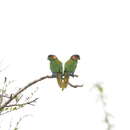Biology
(
англиски
)
добавил Arkive
Flocks of blue-chested parakeets can be observed at forest edges or in the canopy feeding on the seeds and fruits of a variety of trees (2). Breeding apparently occurs in the austral spring from September to December, with two to four eggs typically laid in a nest within a tree cavity (2) (4). The eggs are incubated for 22 to 25 days and the nestling period that follows lasts around 45 days (2).
Conservation
(
англиски
)
добавил Arkive
The blue-chested parakeet is protected by Brazilian law and listed on Appendix I of the Convention on International Trade in Endangered Species (CITES), which prohibits its international trade. Populations occur in Chapada da Diamantina and Monte Pascoal National Parks, Barrolândia Experimental Station, Linhares Forest Reserve, Caratinga Reserve, Rio Doce and probably Desengano State Parks, and Córrego Grande, Córrego do Veado and Sooretama Biological Reserves (4).
Description
(
англиски
)
добавил Arkive
This colourful parakeet is a predominantly green bird with conspicuous red patches on its belly, rump, and shoulder and in front, below and behind the eye (4). The crown is dark brown to blackish, becoming mottled on the nape of the neck, and there is a broad, bright blue bib on the chest, extending thinly around the back of the neck to form a faint collar (2) (4). The outer primaries are blue, and the tail is olive-green above, and brownish red below (2).
Habitat
(
англиски
)
добавил Arkive
Found in the canopy of lowland humid primary Atlantic forest and forest edge, occasionally up to 960 metres above sea level, though generally below 400 metres. This bird also frequents small clearings and selectively logged forest, and tolerates shade plantations where many forest trees are retained (2) (4).
Range
(
англиски
)
добавил Arkive
Formerly common throughout much of south-east Brazil, from Bahia to Rio de Janeiro, the blue-chested parakeet now has a highly fragmented distribution and is mostly restricted to isolated reserves (4).
Status
(
англиски
)
добавил Arkive
Classified as Vulnerable (VU) on the IUCN Red List 2007 (1), and listed on Appendix I of CITES (3).
Threats
(
англиски
)
добавил Arkive
There has been a massive decline in the blue-chested parakeet's population due to extensive, ongoing deforestation for logging operations, agricultural expansion, urbanisation, industrialisation and road building (4). Remaining populations are small and severely fragmented in isolated reserves where protection is often apparently inadequate (4). The species does not seem to migrate and it is believed populations have little ability to move between the now fragmented areas of remaining forest (2). Trapping for the cage-bird trade is a relatively new threat to this species, which is still rare in national and international markets (4).

